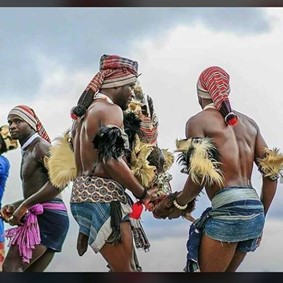Ohafia war dance, or Ikpirikpi Ogu (the art of beheading one’s enemy), is prevalent among the Igbos of South-Eastern Nigeria.
The dance has its roots in Ohafia, a town in Abia State, where oral tradition has it that it was performed to celebrate the victories and spoils of war.
It marks the rich cultural heritage of the Ohafia people and connects to when their ancestors, known for their guile and prowess in battle, were all-conquering.
The dance and dancers are described with much eloquence by John McCall (Dancing the past: experiencing historical knowledge in Ohafia, Nigeria 1993):
‘Several young, robust men, in short, coarsely woven blue loin cloths begin to move into the center of the large clearing..…..Their muscular arms are draped with the long white hair of ram's manes, and on their heads are red, black, and white knit caps known as leopard hats, each pierced with an eagle feather. They move with confidence and pride, but their leader seems even more imposing; balanced on his head is a board upon which human heads sculpted of wood are displayed. The heads also are flanked with ram's mane and capped with leopard hats…….The dance leader, holding a small palm shoot in his mouth and a short cutlass in his right hand, stares fixedly ahead as he dances with short, deliberate steps…….The music is fast, driving, insistent. The dancers are joined by other men, some mature, some mere boys. Each moves his feet in a rapid side-stepping pattern. They roll their shoulders in tight circles, causing their chest muscles to flex rapidly. Gradually, deliberately, the tempo builds. As the pace of the music increases, the pectoral flexing accelerates. The men's chests pulsate with rippling undulations. This is ofufu…….Ofufu is only performed in one context: iri agha, the Ohafia "war dance."’
The Ohafia war dance is performed to the music of the akwatankwa, an instrument fashioned out of bamboo:
‘Three akwatankwa players sit on a wooden bench defining one edge of the dance space. With casual concentration, they tap out the heartbeat of the dance. Beside them, a drummer begins to play, not a dance rhythm, but drum language which is echoed by the antelope horn played by one of the dancers.’ - John McCall.
The Ohafia war dance is about the warriors of old, symbolic of virility, daring, strength, and sanguineness. It is about the achievement of those warriors who must return with a head and become part of the ogbu ishi (beheader) brotherhood.
In modern times the dance continues to symbolise achievement for the people of Ohafia, but that achievement must be brought back home; as McCall points out, achievers ‘who stay in the city and lose contact with their natal villages are….."lost," as were the warriors who failed to return from battle’.
The achiever, like the warrior, must return with his trophy (academic success, an appointment, wealth) to be celebrated, the war dance linking the warrior of old to his modern equivalent.
Sources
Wikipedia
McCall, John (1993). "Dancing the past: experiencing historical knowledge in Ohafia, Nigeria.
oiroegbu.com
legit.ng


